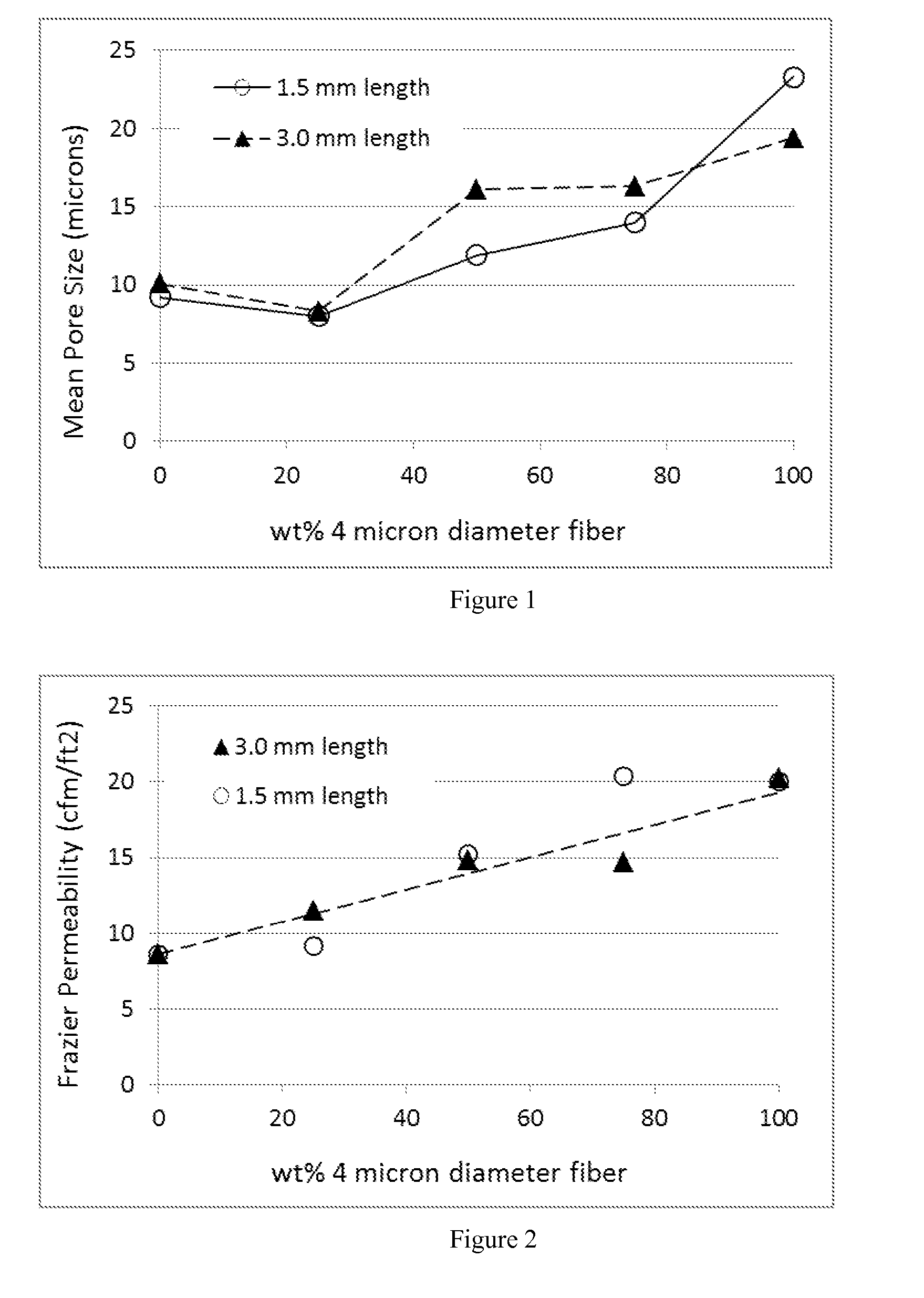Short cut microfibers
a technology of microfibers and microfibers, applied in the field of short-cut microfibers, can solve the problems of difficult disposal of personal care products made from conventional thermoplastic polymers, lack of fibrous articles, and inability to readily disintegrate, so as to reduce the blocking and fusion of fibers
- Summary
- Abstract
- Description
- Claims
- Application Information
AI Technical Summary
Benefits of technology
Problems solved by technology
Method used
Image
Examples
example 1
[0295]A sulfopolyester containing 76 mole %, isophthalic acid, 24 mole % of sodiosulfoisophthalic acid, 76 mole % diethylene glycol, and 24 mole % 1,4-cyclohexanedimethanol with an Ih.V. of 0.29 and a Tg of 48° C. was meltblown through a nominal 6-inch die (30 holes / inch in the nosepiece) onto a cylindrical collector using the conditions shown in Table 1. Interleafing paper was not required. A soft, handleable, flexible web was obtained that did not block during the roll winding operation. Physical properties are provided in Table 2. A small piece (1″×3″) of the nonwoven fabric was easily dispersed in both room temperature (RT) and 50° C. water with slight agitation as shown by data in Table 3.
TABLE 1Melt Blowing ConditionsOperating ConditionTypical ValueDie ConfigurationDie tip hole diameter0.0185 inchesNumber of holes120Air gap0.060 inchesSet back0.060 inchesExtruder Barrel Temperatures (° F.)Zone 1350Zone 2510Zone 3510Die Temperatures (° F.)Zone 4510Zone 5510Zone 6510Zone 7510Zon...
example 2
[0296]A sulfopolyester containing 89 mole %, isophthalic acid, 11 mole % of sodiosulfoisophthalic acid, 72 mole % diethylene glycol, and 28 mole % ethylene glycol with an Ih.V. of 0.4 and a Tg of 35° C. was meltblown through a 6-inch die using conditions similar to those in Table 1. A soft, handleable, flexible web was obtained that did not block during a roll winding operation. Physical properties are provided in Table 2. A small piece (1″×2″) of the nonwoven fabric was easily and completely dispersed at 50° C. and 80° C.; at RT (23° C.), the fabric required a longer period of time for complete dispersion as shown by the data in Table 3.
[0297]It was found that the compositions in Examples 1 and 2 can be overblown onto other nonwoven substrates. It is also possible to condense and wrap shaped or contoured forms that are used instead of conventional web collectors. Thus, it is possible to obtain circular “roving” or plug forms of the webs.
example 3
[0303]A circular piece (4″ diameter) of the nonwoven produced in Example 2 was used as an adhesive layer between two sheets of cotton fabric. A Hannifin melt press was used to fuse the two sheets of cotton together by applying a pressure 35 psig at 200° C. for 30 seconds. The resultant assembly exhibited exceptionally strong bond strength. The cotton substrate shredded before adhesive or bond failure. Similar results have also been obtained with other cellulosics and with PET polyester substrates. Strong bonds were also produced by ultrasonic bonding techniques.
PUM
| Property | Measurement | Unit |
|---|---|---|
| aspect ratio | aaaaa | aaaaa |
| aspect ratio | aaaaa | aaaaa |
| aspect ratio | aaaaa | aaaaa |
Abstract
Description
Claims
Application Information
 Login to View More
Login to View More - R&D
- Intellectual Property
- Life Sciences
- Materials
- Tech Scout
- Unparalleled Data Quality
- Higher Quality Content
- 60% Fewer Hallucinations
Browse by: Latest US Patents, China's latest patents, Technical Efficacy Thesaurus, Application Domain, Technology Topic, Popular Technical Reports.
© 2025 PatSnap. All rights reserved.Legal|Privacy policy|Modern Slavery Act Transparency Statement|Sitemap|About US| Contact US: help@patsnap.com



